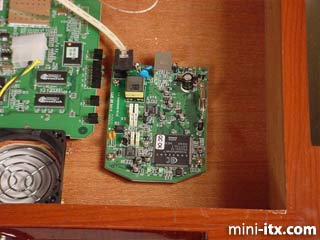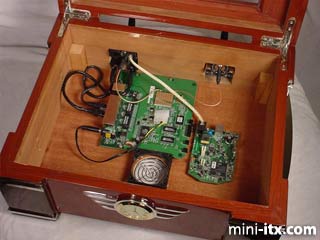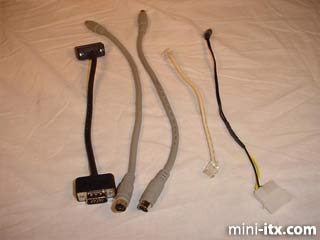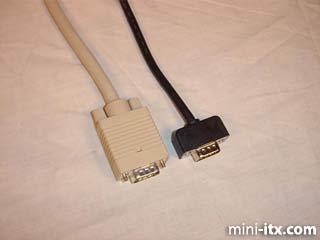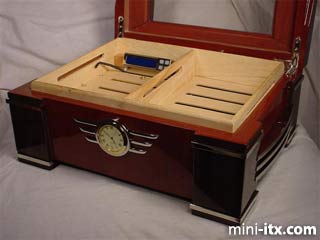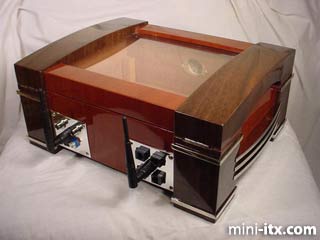The "Humidor CL Server"
This is a naked Linksys USB ADSL modem. I originally used a Speedstream unit but after letting smoke out on one and having difficulties powering another one I decided to go with a USB powered unit.
Overview of lower components. The fan looking thing is the shroud from a 60mm fan. You have probably figured out by now that the CL10000 board is mounted upside down. The 40mm CPU fan fits down into this shroud allowing it to take a suction directly from the cool outside air. The humidor has a clearance of 3/4" so airflow is not a problem. Also seen in this picture are the two Linksys antenna cables leading to the back of the box. Ethernet cables are also routed from the hub to the back. The white cable is a phone line bringing the DSL signal to the modem.
The keys to this project. Short cables. The first humidors I built had simple holes in the back of the case to pass cables through. This allowed me to position the mainboard anywhere I wanted inside the box. The downside of this design, besides being ugly, was "hard-wired" cabling had to be used. I was rightfully criticized for this. I responded with the V series, which has the traditional back, plate scheme but this caused me to lose the freedom of placing the components where I thought they were best suited. For this project I used a hybrid scheme where I install pass-through I/O plates on the back of the humidor and run short lengths of cable inside the piece from the components to the I/O plate. The server role of the piece lends itself to this design because servers traditionally don't need a lot of I/O. Pictured here is the VGA, PS2, ADSL (regular phone line) and a special cable I built. It provides 12V power from a computer Molex connector to the Linksys routers' DC barrel plug.
The VGA cable is the showstopper. Without this 8" little jewel this project would not have happened. The only place on the planet you can get one of these things is at Hall Research Technologies. Lauren listened to my pitch and graciously sent me a cable to use. This picture shows the cable next to a regular VGA cable. Slim cable, abbreviated head and short length. They also make longer lengths. Big shout out to Hall Research.
Coming together. The tray rests on supports and all the cables are attached.
Back side shot showing the chrome I/O plates and twin Linksys antennas. I was very prepared to cut a cooling hole between the two plates but after extensive testing I found it wasn't necessary. I was surprised. Apparently there is enough leakage around the lid to allow the hot air to escape. It ran between 100 to 110 degrees F inside the case and the CPU temp wasn't an issue because it got direct outside air. Another big reason for the low temps was the steady state server role.




